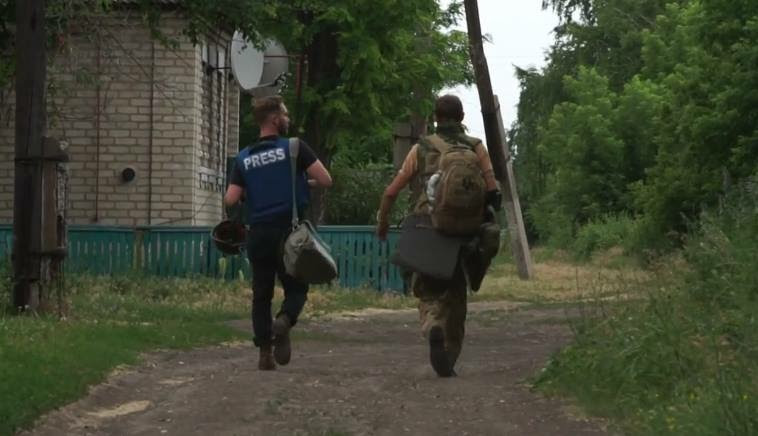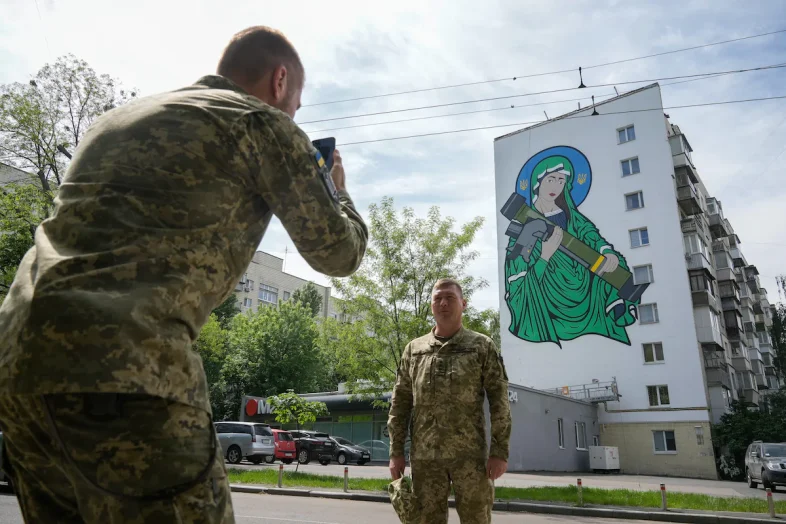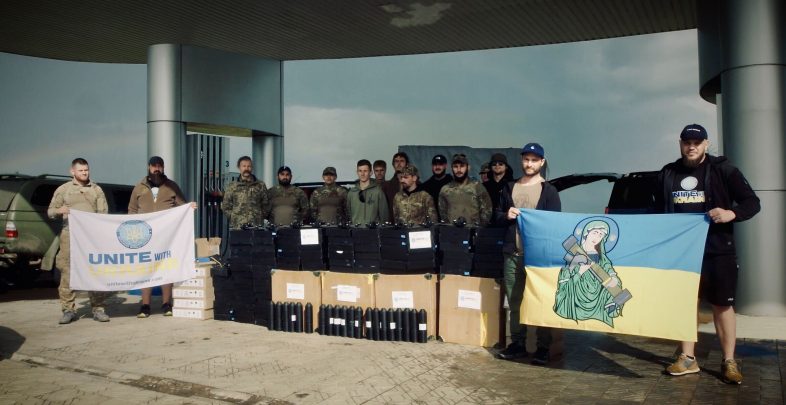The symbol of ‘Saint Javelin’ has become emblematic of the Russian-Ukrainian war. It might be better known abroad than in Ukraine itself, but that only proves its unique impact. The Saint Javelin initiative, launched in the early days of the Russian invasion of Ukraine in February 2022, has grown into a significant global advocacy platform for Ukraine. For several years, it has been raising funds for Ukraine’s Armed Forces. Over 100,000 people from more than 65 countries have purchased Saint Javelin products, contributing to Ukraine’s future victory. By uniting pro-Ukrainian supporters worldwide, Saint Javelin has raised approximately $2.5 million, which has been used to support Ukrainian soldiers and their families.
In an interview with The Ukrainian Week, Christian Borys, the founder and leader of Saint Javelin, discusses the initiative’s current development, global support for Ukraine, and international perceptions of the war. He recently returned to Ukraine, bringing thoughtful gifts for our soldiers.
Christian has strong ties to Ukraine. He grew up in a Ukrainian-Polish family in Canada, where his parents had fled from the former communist regime in Poland. From 2015 to 2018, he worked as a journalist in Ukraine, covering the Russian war in the east of Ukraine, which gave him a deep understanding of our challenges. This experience and his awareness of Russia’s intentions and capabilities motivated him to create an online charity merchandise store featuring the symbol of ‘Saint Javelin’ just a week before the full-scale invasion.
***
When you were in Ukraine after the Revolution of Dignity and reported on the events in Donbas, did you anticipate that a war of this scale would happen here?
– I remember seeing those news reports in the media space at the time and thinking it was impossible. Various people, including journalists, kept saying there would be a new attack on Mariupol, saying that war would start. These conversations went on every year, so no one took them seriously and thought it was just impossible. Even on that apocalyptic day, February 24, when Russia had already begun its attack, people still didn’t believe it. And I didn’t believe it, even though we had been watching their troops build up on the border for months. But I couldn’t believe that something like this could happen at all.
The only time I thought something similar might happen was when Trump was elected President of the United States. In January 2017, certain disturbances occurred in Avdiivka, and as a journalist, I went there. The tension was indeed higher, and I wondered if it might be the beginning of a new attack or operation. But it only lasted a few weeks.

Photo: Christian Borys in Ukraine during his journalist assignment in 2016
– How does the world perceive this war? We Ukrainians see it as significant and fateful, believing the world should offer more support and help. But how does it look from the outside?
– I always stress to people that this isn’t just about Russia. We’re seeing alliances or blocs forming where Russia, China, Iran, and North Korea are actively resisting the Western world and its values. Their goal is to undermine the Western way of life and its core values. Ukraine is just the starting point. If we fail to stop them here and now in Ukraine, they’ll gain momentum and extend their influence. Taiwan, other countries, and regions across the globe could be next. I always emphasise that what’s happening here and now is a decisive battle. We’re at a crossroads where we must decide whether to allow their westward expansion or halt them right here in Ukraine. It’s crucial now to demonstrate whether NATO is truly as strong and capable as it claims to be. Perhaps Putin was right in suggesting NATO’s vulnerability and the ease with which he could destabilise it from within. Can this alliance really confront global threats? In my view, this is nothing short of the third world war.
– Do ordinary Canadians or Americans share your viewpoint, or is it primarily a concern for politicians?
– In Canada, there was initially strong support for Ukraine. However, when something happens so far away geographically, it’s challenging for ordinary people to grasp the reality, feel a personal connection, and worry about it daily. With COVID, Canada faces significant economic and political issues, so people are more focused on immediate concerns affecting them directly rather than global issues.
In the United States, there’s a deep divide. There’s considerable support for Ukraine, and economically, it’s beneficial for the country to provide support. But politically, divisions are so stark that support can be undermined simply to criticise opponents. It’s a complex problem, and frankly, I see no clear solution in sight.
– Who are these people donating to your project? Are they mostly Ukrainians, or are they people who, even though they’re not Ukrainian and live on the other side of the planet, still care about Ukraine’s fate?
– These are people from all around the world. When we started, we sold Saint Javelin stickers in over 110 countries, even in China and Mali in Africa — I’m not sure how it got there. We’ve seen them in Venezuela, Colombia, and Brazil, but now it’s mostly Canada, America, and Europe.
Who are these people? They’re the ones looking for quick information, not lengthy analyses. They want memes and videos, and they wear T-shirts and stick stickers to show their support for Ukraine. Initially, it was a lot of military personnel — Americans, Canadians, and others — but now it’s ordinary civilians. As we showed what was happening to civilians in Ukraine, like in Bucha, for instance, or other incidents, more people around the world were touched by it. They saw Russia’s actions with its missile strikes and attacks and wanted to support the smaller country, the underdog in this situation.

Photo: Saint Javelin mural in Kyiv
– Did your efforts and various other channels, including official ones, contribute to this success?
– I used to work as a journalist, so I had a good grasp of the situation and understood the context. However, when I launched Saint Javelin, I stepped away from journalism, which gave me more freedom to express my own thoughts and vision. I believe people began to realise that Russia consistently spreads lies and misinformation that don’t reflect reality. Mainstream media often aim for a balanced or neutral approach. When I started sharing videos and memes that were sharp and direct and highlighted the misinformation spread by Russia, people found it refreshing and engaging. That’s why they liked it, and our content started to gain traction and be widely shared.
– Does interest in the matter and, subsequently, donations wane over time? How is the project currently progressing, and what strategies are you using to maintain the public’s interest in it?
– There is no doubt that, initially, situations like this garner a lot of attention and concern from many people. However, over time, attention naturally decreases. The only thing you can do is to keep presenting the information to the smaller group of people who still follow it. We continue to showcase what is happening to ordinary people, just like those who support us. Mechanics and doctors, for instance, who were simply living their lives, have been impacted by Russia’s actions. We aim to highlight that they are ordinary people who happen to live in a different country.
– How involved are Ukrainians living abroad in your initiative?
– Around 60–70% of our audience consists of foreigners with no ties to Ukraine or Ukrainian roots, while the remaining 30–35% are part of the Ukrainian diaspora. Currently, I notice there’s a sense of fatigue setting in from continuous support. Initially, it was crucial for people to express their heritage, which they were eager to do. However, this enthusiasm has gradually waned. In Canada, for instance, there were many cars displaying Ukrainian flags initially, but now you see it less frequently, perhaps once a day. As for our non-Ukrainian audience, I think it’s challenging for them to sustain continuous support because they are physically distant. They might also have found other organisations to engage with during this time.
– What products do you offer? What do customers usually purchase from you?
– Initially, it all began with the Saint Javelin sticker. Soon, people from various countries started requesting different designs. For instance, individuals from Britain asked for the Saint NLAW, desiring a symbol that could represent their support and connection to Ukraine. We developed several designs like Saint NLAW, Saint Stinger, Saint Panzerfaust, Saint Gustaf, and Saint HIMARS. However, we soon realised that these unique and somewhat eccentric designs wouldn’t sustain long-term popularity.
Subsequently, we decided to manufacture our clothing here in Ukraine. Initially, our focus was solely on donations. However, we recognised that producing our items locally would provide the maximum economic benefit to Ukraine. This was a priority for us, as we wanted to avoid manufacturing in China. Initially, we had mugs made in China available on our site, which didn’t align with our values and received negative feedback. Consequently, we discontinued selling them and, two years later, found a Ukrainian manufacturer to produce the mugs for us.
Currently, our production in Ukraine spans across five cities: Kyiv, Kharkiv, Lviv, Odesa, and Dnipro. Alongside this, we began donating various clothing items to soldiers such as fleeces, hats, balaclavas, socks. The soldiers provided valuable feedback to help us refine these products, which we then offered for sale on our site to our regular audience.
My aim is to establish a brand akin to Patagonia or Fjallraven, renowned for their strong social missions. Patagonia, for instance, focuses on preserving nature and combating climate change, while Fjallraven is a well-known Swedish brand that proudly represents Sweden globally. Similarly, I aspire to create a brand with a mission to support and showcase Ukraine on the world stage. Unlike brands similar to M-TAC, for example, which specialise in technical military gear, we do not produce purely military items due to the lack of a technical component. Instead, we draw inspiration from military aesthetics and create products infused with military themes. This approach allows us to offer unique and meaningful products that resonate with our mission to promote Ukrainian identity and solidarity.
— When the Russian invasion began, you planned on selling war trophies or some artistic works made from these trophies at auctions. Have you been able to proceed with this project?
— We most certainly have. For the auctions, we created statues resembling Saint Javelin, some of which were signed by General Zaluzhny and crafted from Russian tanks. We auctioned three of them in Toronto, fetching around 60,000 Canadian dollars for the lot. Another was sold in Chicago for approximately 30,000 dollars. Additionally, we auctioned off an illustration by Ukrainian artist Maxim Pavlenko, contributing to a total of about 100,000 dollars raised. We even auctioned an ancient Ukrainian helmet that sold for 7,000 dollars.
Afterwards, we began selling items made from recycled artillery shell casings, like this coin. Keychains and small Saint Javelin statues also sold very well. People appreciate these unique items, which they can’t find elsewhere, crafted by veterans here in Ukraine.
– Where do the funds go? Are they used for the urgent needs of soldiers on the front lines or for funding certain programs?
– The World Congress of Ukrainians and their ‘Unite with Ukraine’ program are our largest partners, whom we support extensively. We’ve funded various initiatives, ranging from drones and FPV technology to tactical medicine and the procurement of non-lethal weapons. We’ve also contributed to their campaigns to purchase armoured vehicles and supported the Azovstal Defenders’ Families Fund. Additionally, we collaborate with the 2402 Fund, which aids journalists working in Ukraine. Furthermore, we’ve purchased approximately ten vehicles for diverse needs.
Through our website sales, we donate a portion of the proceeds, but we also leverage our large social media audience (about 10 million users) to amplify other fundraisers, initiatives, and programmes. For instance, we partnered with the World Congress of Ukrainians on initiatives like ‘Santa’s Birds’, which raised funds for FPV drones during Christmas. Tomorrow, we’re delivering these drones worth around $250,000 to soldiers in Mykolaiv, a testament to our collaborative efforts.

Photo: Christian Borys from Saint Javelin and Andriy Potichnyi from the World Congress of Ukrainians deliver charitable aid to ‘Da Vinci Wolves’ Battalion
– Were there times when you had to struggle with Ukrainian bureaucracy?
– We haven’t faced any major bureaucratic hurdles or unexpected challenges. Generally, our operations run smoothly. The only area where we encounter difficulties is with customs — both imports and exports. However, I take full responsibility for these issues as they stem from my lack of experience and understanding of the local system. Aside from that, we deal with the usual challenges that any international business encounters.
When I started this initiative, my primary focus was on highlighting what happens after the war. People often pay more attention to the war itself — the attacks, the shelling, the missile strikes — but they rarely consider the aftermath. The impact of war stays with these communities; it doesn’t just vanish. Recognising this, it became crucial for me to create something that helps people remember the long-term consequences of conflict and supports those affected by it. Continuing this mission remains a personal commitment for me.
– What motivates you personally to do this?
—Whenever I witnessed a stronger individual harming someone weaker, I’ve always experienced a deep sense of empathy, compassion, and a strong urge to assist the vulnerable. That’s just how I perceive the world. As for Saint Javelin, truth be told, I’ve never expected this initiative to grow to this extent. Initially, I imagined raising a few hundred dollars and leaving it at that. But when it exploded and became so significant, I felt an immense weight of responsibility. For me, it’s primarily about responsibility—what more can we do, and how can we improve to aid Ukraine better? For instance, I’m currently in Ukraine, meeting with various manufacturers, partners, and organisations this week, striving to enhance our efforts. That’s my sense of responsibility, coupled with the feeling of being part of something much larger than myself.

